
* In the 1960s, aircraft manufacturers began to consider a second generation of jetliners -- one focus being on increasing capacity through "widebody" aircraft configurations. Among the results of this exercise were two three-engine "jumbo jets": the McDonnell Douglas DC-10 (and improved MD-11), plus the less successful Lockheed L-1011 Tristar. This document provides a history and description of the DC-10 and L-1011.
* With the coming of age of the commercial jetliner in the late 1950s and early 1960s, aircraft manufacturers considered what they wanted to do next with jetliner technology. One option was to develop supersonic transports (SST), which seemed a sexy and appealing idea at the time, but which proved a notion of dubious economic utility, and a dead end.
Another option was to simply develop bigger jetliners with more passenger capacity, an exercise seeded by the US Air Force (USAF) under the service's "Cargo Experimental -- Heavy Logistics System (CX-HLS)" program to develop a heavy jet cargolift aircraft. Proposals were submitted by America's aircraft manufacturers, with Lockheed winning the competition with its C-5 Galaxy.
Boeing used its CX-HLS proposal as a basis for the Boeing 747 jumbo jetliner. The 747 would prove a great success, but it did get off to a slow start because many airlines saw it as bigger than they needed. American Airlines issued a requirement for a jetliner bigger than existing machines, but smaller than the 747, that could operate out of airports with shorter runways. Douglas, working from its own CX-HLS proposal, came up with a series of concepts, finally settling on a wide-body, single-deck, trijet configuration -- an engine on a pylon under each wing and an engine at the base of the tailfin.
Initial orders for the "DC-10" were placed by American Airlines and United Airlines in 1968. By that time, Douglas had merged with the McDonnell company to result in "McDonnell Douglas (MDD)", though the DC-10 retained its "Douglas Commercial" designation; the merger, incidentally, resolved funding problems that had afflicted the DC-10 development program. The first DC-10, in the "Series 10 / DC-10-10" configuration, performed its initial flight on 29 August 1970, the variant being certificated and entering commercial service in the summer of 1971.
* The DC-10-10 provides a useful baseline for the family. It was an all-metal aircraft, built mostly of aircraft aluminum, with a low wing: all-swept flight surfaces; tricycle landing gear, and as mentioned three engines, one on a pylon under each wing, one at the base of the tail. The tail installation was clean and straightforward, but it did make swapping out an engine troublesome.
The Series 10 was powered by General Electric CF6-6D turbofans providing 178 kN (18,145 kgp / 40,000 lbf) thrust each. There was a small raked fin on both upper sides of each underwing engine nacelle to maintain airflow over the top of the wing at high angles of attack, lowering the stall speed. Some DC-10-10s were fitted with the slightly more powerful Cf6-6D1 engine with 182.4 kN (18,600 kgp / 41,000 lbf) each; it is unclear if the -6D1 fit was later production, or a customer order option.
An AiResearch TPSC-700-4 auxiliary power unit (APU), located in the tail, provided starting and ground power. Descriptions of the fuel tank arrangement of the DC-10s are not entirely clear: it seems there were three integral fuel tanks in each wing, for a total capacity of 82,142 liters (21,700 US gallons) in normal flight condition. If lightly laden, the Series 10 could carry an additional 18,473 liters (4,880 US gallons) -- that is, the typical fuel load was limited not by tank volume, but by weight.
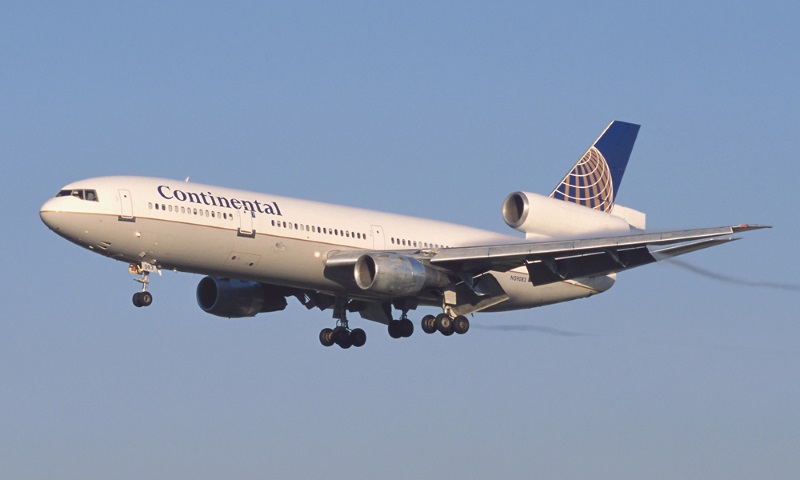
The wing had a sweepback of 35 degrees at quarter chord and a slight dihedral, the dihedral decreasing outward along the span. Wing angle of incidence was positive at the root, twisting subtly to negative at the wingtip. The wing featured full-span two-position leading-edge slats, with two slat segments inboard of the engine, six outboard. Trailing-edge flight controls included, from the wing root outward:
The tailplane featured elevators, each with two segments, while the tailfin featured a rudder with top and bottom segments, both split into fore and aft segments. The twin-wheel steerable nose gear retracted forward, while the four-wheel main gear -- in a 2x2 bogey arrangement -- retracted inwards from the wings towards the fuselage. Flight surfaces and landing gear were actuated by a triple-redundant hydraulic system, with the landing gear falling down and locking if hydraulic systems failed.
___________________________________________________________________
MCDONNELL DOUGLAS DC-10-10:
___________________________________________________________________
wingspan:
47.34 meters (155 feet 4 inches)
wing area:
358.7 sq_meters (3,861 sq_feet)
length:
55.3 meters (181 feet 5 inches)
height:
17.7 meters (58 feet 1 inch)
empty weight:
111,085 kilograms (244,905 pounds)
MTO weight:
206,385 kilograms (455,000 pounds)
max cruise speed:
905 KPH (575 MPH / 500 KT)
service ceiling:
10,730 meters (35,200 feet)
range, max payload:
4,355 kilometers (2,705 MI / 2,350 NMI)
___________________________________________________________________
Along with cabin attendants, there was a flight crew of three -- pilot, copilot, and flight engineer -- plus seats for two cockpit observers. Flight avionics were conventional, with radios, intercom, identification transponder, radio navigation aids, landing aids, and a weather radar in the nose. There were twin aisles in the passenger cabin, with seats six across in first class and eight across in coach. Typical mixed-class capacity was 255 or 270, with up to 380 seats in an "all-economy" configuration. Up to nine lavatories could be installed, and there was overhead baggage storage. There were four doors on each side of the fuselage, all opening inward and sliding upward. Of course, accommodations were pressurized and climate-conditioned.
There was a lower cargo deck, with holds fore and aft of the wing, with an outward-opening door to each hold on the right of the aircraft. There was also an aft cargo compartment, with the door on the left side of the aircraft. Where the DC-10-10 gets a bit confusing is that, it appears by default, the galley was also on the lower deck, it seems at the front of the forward cargo hold, with food carts drawn up to the passenger deck by two elevators into an upper deck handling area. Comments of flight crew suggest food containers were loaded in through the forward cargo door and then wheeled into place. Apparently there was a window at the front of the galley to allow the crew to check if the front landing gear was really down and locked.
What makes this issue more confusing is that some DC-10s had the galley in the rear of the passenger deck, improving convenience at the expense of passenger seating -- instead of, as with the lower floor galley, at the expense of cargo capacity. While the galley configuration is associated with specific DC-10 variants in sources, reminiscences of flight crew suggest it was an option based on customer request, and might vary among aircraft of the same series. The issue is not considered further here.
BACK_TO_TOP* A total of 122 DC-10-10 jetliners was built in all; a "combi" or "convertible freighter" passenger-cargo variant, the "DC-10-10CF", was introduced as well. Its primary distinguishing feature was an upward-hinged cargo door on the forward left side of the fuselage, 2.59 meters high and 3.56 meters wide (8 feet 6 inches by 11 feet 8 inches). The -10CF could be configured for all-passenger operations, with the same capacity as a stock DC-10; or for cargo operations; or any mix of the two, with cargo in the front and passengers in the rear, separated by a moveable bulkhead. Configuring for cargo hauling involved yanking passenger kit, then installing roller and tie-down systems. Only nine such freighters were built.
Of course, along with the domestic Series 10, MDD needed to offer an intercontinental version, with what was initially designated the "Series 20" performing its initial flight on 28 February 1972. It was actually introduced later in 1972 as the "Series 40", and featured:
One of the puzzles of the Series 40 is that it was 20 centimeters (8 inches) longer than the Series 10, even though the fuselage length was the same; all DC-10s had the same fuselage length. It appears the length change was due to thrust reverser configuration. The Series 10 originally had both fan and engine core thrust reversers on all three engines, but the engine core thrust reversers proved both unnecessary and unreliable -- there are tales of core thrust reversers being left behind on the runway. In any case, the core thrust reversers were quickly deleted, with engine tailcones in their place, resulting in the slight length increase.
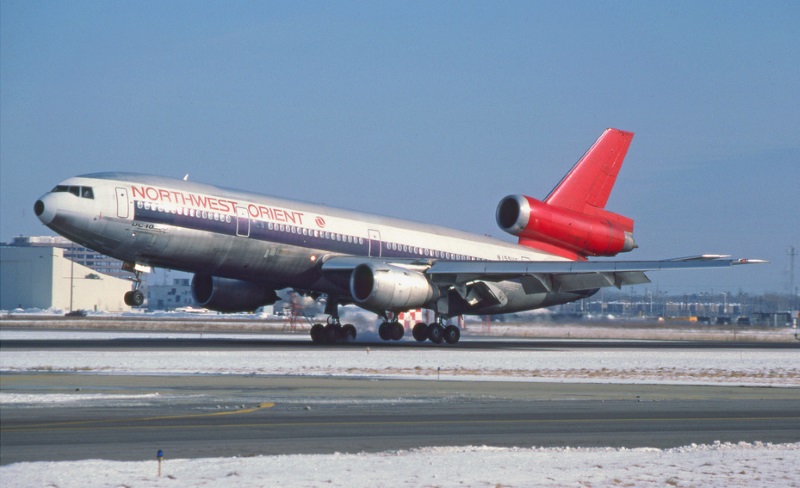
22 DC-10-40 jetliners were built for Northwest Orient. Another batch of 20 was built for Japan Air Lines (JAL), featuring more powerful JT9D-59A turbofans with 236 kN (24,040 kgp / 53,000 lbf) thrust each. First flight of a JAL DC-10-40 was in 1975.
* The "definitive" DC-10 was the Series 30, which performed its initial flight on 21 June 1972. It was much the same as the Series 40, but with GE CF6-50A or -50C turbofans providing 233.5 kN (22,220 kgp / 49,000 lbf) thrust each. Later production had CF6-50C1 or -50C2 engines with 233.5 kN (23,800 kgp / 52,500 lbf) thrust, or CF-50C2B engines with 236 kN (24,400 kgp / 53,000 lbf) thrust. It seems that the Series 20 designation was changed to Series 40 at the request of Northwest, which wanted to trump the Series 30 being obtained by competitors. A total of 163 DC-10-30 jetliners was built.
A combi passenger-cargo variant, the "DC-10-30CF", was introduced in early 1973. Its primary distinguishing feature was the cargo door fitted to the left forward fuselage, introduced on the -10CF. The -30CF could be configured for all-passenger operations, with the same capacity as a stock DC-10; or for cargo operations, hauling up to 64,860 kilograms (143,000 pounds) internationally, or up to 70,626 kilograms (155,700 pounds) domestically; or any mix of the two. In addition to the DC-10-30CF, a pure freighter version, the "DC-10-30AF", was introduced, with ten built.
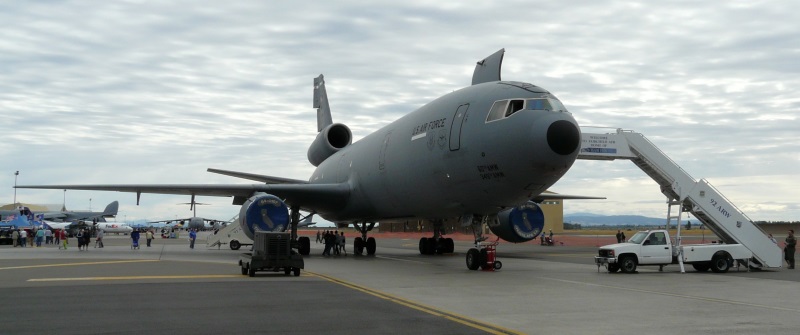
An inflight refueling tanker variant of the DC-10-30CF, the "KC-10", was built for the US Air Force, with 60 delivered from 1981 to 1988. Two similar machines were converted from DC-10-30CF aircraft for the Royal Netherlands Air Force, to be designated "KDC-10". Another conversion, of a DC-10-40, is operated by a commercial firm named Omega Flight Services for tanker and transport operations on hire. The Dutch retired one of their KDC-10s in 2019, with the other to be retired in 2023; they will be replaced by the Airbus A330 Multi-Role Tanker-Transport. Omega is buying both of the KDC-10s.
The USAF conducted an upgrade program for all their KC-10s from 2011 to 2017, involving replacement of the original KC-10 flight management system with a new "Communication, Navigation, Surveillance/Air Traffic Management (CNS/ATM)" system, which is more maintainable and more capable. The Air Force has no formal plans to retire the KC-10s, but is giving the matter some thought.
From 1980, an extended range "Series 30ER" was offered, the essential change being installation of another fuselage fuel tank, it appears in the rear of the forward cargo hold. More powerful CF6-50C2B engines with 240.2 kN (24,500 kgp / 54,000 lbf) thrust were fitted to handle higher takeoff weights -- ratings given for the -50C2B on the Series 30 were lower, it is unclear if that is in error, or if they were derated. Initially, the new fuel tank had a capacity of 5,807 liters (1,534 US gallons); a bigger fuel tank storing 12,556 liters (3,317 US gallons) was offered later. A number of retrofit kits were sold to upgrade DC-10s to Series 30ER configuration. Only six were built, with five DC-10-30s also upgraded to -30ER configuration.
The last variant of the DC-10 to be introduced was the "DC-10-15CF", effectively a DC-10-10 with more powerful CF6-50C2F powerplants for "hot and high" operation. Seven were built in the early 1980s for service in Mexico.
* Probably the most enthusiastic operator of the DC-10 was US parcel service Fedex, which found the type's cargo capacity well-suited to their work. Over the years, Fedex obtained a number of DC-10s -- many of them used, many conversions of jetliners-- including 47 DC-10-10s; 46 DC-10-10Fs; 8 DC-10-10CFs, 10 DC-10-30Fs; and 5 DC-10-30Fs.
Many of the Fedex machines, as well as DC-10s flown by other operators, were updated to the "MD-10" configuration, with a glass cockpit like that of the MD-11, discussed below. All the Fedex DC-10s were retired by the end of 2023. Five DC-10s were modified as air tankers for fire-fighting, their large size allowing them in principle to suppress small fires in one shot, with some of them still flying. The end of the DC-10's days is not far off, however.
BACK_TO_TOP* The last of 446 DC-10s was rolled out in 1989, but that wasn't the end of the line. Considerations from the mid-1970s by MDD engineers of a stretched DC-10 led to a considerable tweaking of the DC-10, the program formally being started in 1986. A number of variations of what became known as the "MD-11" were considered, with the result being a DC-10-30 with new technologies; a fuselage stretch of 5.66 meters (18 feet 7 inches); and a baseline passenger capacity of 320 passengers. Initial flight of the prototype was on 10 January 1990. Initial customer deliveries were in late 1990.
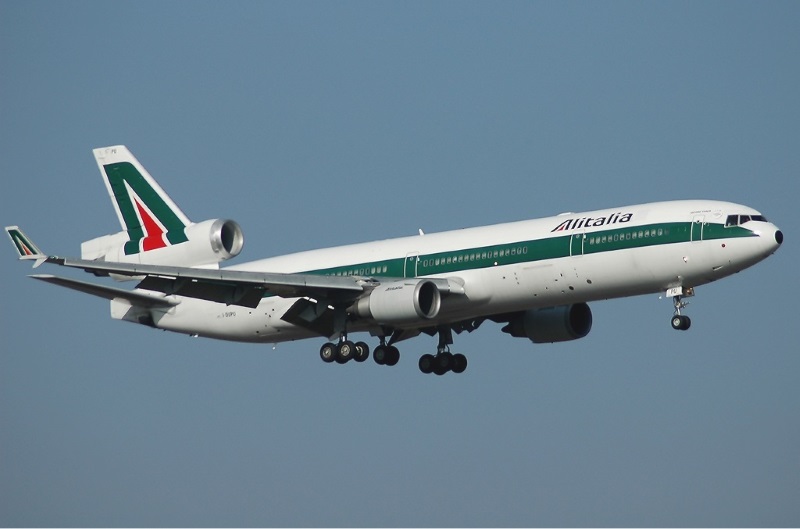
The MD-11 looked close enough to a DC-10 to be confused for it, except for its distinctive wingtip winglets, which suppressed wingtip vortexes that caused drag and reduced fuel economy. The MD-11 had more improvements than that, however, such as revised flight surfaces, modernized engines, and a "glass cockpit". The cockpit design featured six CRT displays and was known as the "Advanced Common Flightdeck (ACF)". Avionics included a dual flight management system and GPS navigation receiver.
___________________________________________________________________
MCDONNELL DOUGLAS MD-11:
___________________________________________________________________
wingspan:
47.34 meters (155 feet 4 inches)
wing area:
358.7 sq_meters (3,861 sq_feet)
length:
55.3 meters (181 feet 5 inches)
height:
17.7 meters (58 feet 1 inch)
empty weight:
111,085 kilograms (244,905 pounds)
MTO weight:
206,385 kilograms (455,000 pounds)
max cruise speed:
905 KPH (575 MPH / 500 KT)
service ceiling:
10,730 meters (35,200 feet)
range, max payload:
4,355 kilometers (2,705 MI / 2,350 NMI)
___________________________________________________________________
A total of 131 baseline MD-11 jetliners, sometimes informally designated "MD-11P", was built from 1988 to 1998. Other variants included:
The higher MTO and some improvements in aircraft assemblies introduced in the MD-11ER were flowed into standard MD-11 production and available as retrofits.
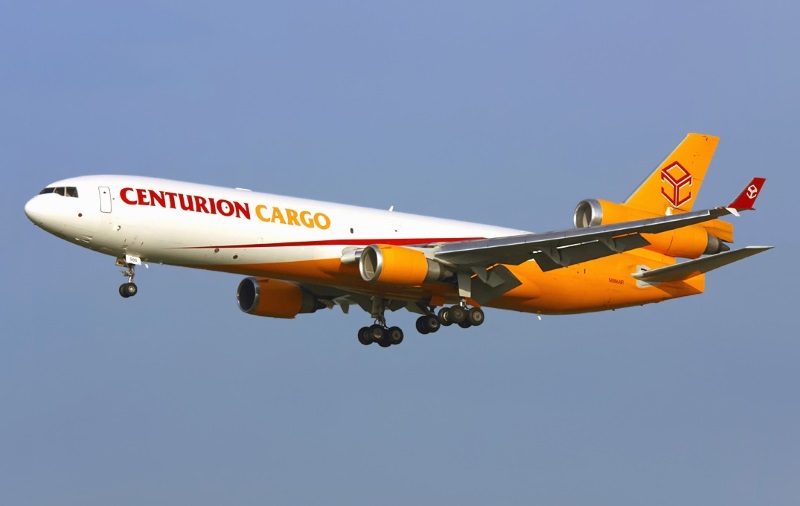
Although MDD considered other variants, after the firm was absorbed by Boeing in 1997, production of the MD-11 was phased out, the last jetliners being delivered in 1998, and the last freighters being delivered in 2001. Sales had been in decline and Boeing preferred to focus on their 777 jetliner. Boeing did perform conversions of existing MD-11 jetliners to freighter configuration under the "MD-11 Boeing Converted Freighter (BCF)" program.
BACK_TO_TOP* While MDD was working on the DC-10, the Lockheed company was working on a comparable trijet jumbo jetliner, the "L-1011 Tristar". Although Lockheed had been a significant manufacturer of commercial aircraft in the piston era, most prominently represented by the elegant Super Constellation airliner, the company had problems moving into the commercial jet age. In the late 1950s, Lockheed had introduced the L-188 Electra four-turboprop airliner, which proved a financial drain on the company, particularly after several high-profile accidents. The saving grace of the Electra was that it led to the highly successful P-3 Orion maritime patrol aircraft, one of the mainstays of Western defense during the Cold War, remaining in service into the 21st century.
In the late 1960s, Lockheed was suffering from slow military business, and when American Airlines came up with the proposal that led to the DC-10, Lockheed management decided to take a shot at it as well with the "L-093" design, which would emerge as the L-1011. American's selection of the DC-10 was a blow to Lockheed, but not a fatal one, the company obtaining advance orders from TWA and Eastern Air Lines.
Lockheed chose the Rolls-Royce RB211 turbofan to power the Tristar, which is where the trouble began. Development of the RB211 proved more difficult than anticipated, helping to drive Rolls-Royce into bankruptcy in early 1971. That meant Lockheed didn't have an engine, with a fire drill conducted to evaluate alternatives. The British government bailed out Rolls-Royce, on the condition that the US government provide assistance to Lockheed to make sure there was a customer to support RB211 sales.
The initial prototype Tristar had already performed its first flight on 16 November 1970. The engine problems delayed service introduction, with FAA certification finally granted in the spring of 1972, and initial deliveries of the baseline "L-1011-1" variant to Eastern immediately following. By that time, the DC-10 had been in service for the better part of a year.
* The "Ell-Ten-Eleven" had such a strong resemblance to the DC-10 as to make it easily confused with it, at least by people without a detail familiarity with aircraft. The L-1011-1, built for short- or medium-haul domestic routes, was an all-metal, low-wing jetliner with all-swept flight surfaces; tricycle landing gear; and three engines, one on a pylon under each wing and one in the tail. The big recognition feature relative to the DC-10 was that the tail engine, instead of being mounted under the tailfin, was mounted in the tail, with the intake forward of the tailfin feeding the engine through an S-shaped duct. At the outset, the powerplant was the RB.211-22B, each of the three engines providing 187 kN (19,050 kgp / 42,000 lbf) thrust.

The wings had 35-degree sweep at quarter chord. Each wing had full-span leading-edge slats, with three inboard of the engine, four outboard. On the rear of the wing, from the wingroot out there was a double slotted flap, with two spoilers in front; a high-speed aileron; another double slotted flap, with four spoilers in front; and a low-speed aileron out to the wingtip. The tail arrangement was conventional, with rudder and ailerons, though the tailplane was variable incidence for flight trim. The steerable nosewheel retracted forward, while the main gear -- with four wheels in a 2x2 bogey arrangement -- retracting inward from the inboard wing into the fuselage. The landing gear was hydraulically retracted, being driven by four independent hydraulic systems, which also drove nosewheel steering, normal brake actuation, and primary flight control surfaces.
The L-1011 included an advanced autopilot with a "fly-by-wire" flight control system, something very new at the time; in 1972, a Tristar flew a trip across the USA under generally automated control as a demonstration. Other avionics included an inertial navigation system; a "Direct Lift Control" scheme that automatically tweaked spoilers to help provide smooth landings; plus radios, radio navigation and landing aids, identification transponder, and a weather radar in the nose.
There were three flight crew -- pilot, copilot, and flight engineer -- not including cabin attendants. The Tristar had a twin-aisle interior, with a maximum seating of 400 passengers in an all-economy "cattle car" configuration, featuring 10-across seating, though a more reasonable mixed configuration was 256 passengers, with first-class having 6-across seating. There were two lavatories forward, five aft, and as with the DC-10 the galley was in the lower cargo hold, presumably at the front of the forward hold. Apparently there was an option for a rear galley on the passenger deck in some later variants, increasing cargo space at the expense of passenger seating. Of course, accommodations were pressurized and climate-conditioned.
There were four doors on each side, with one behind the cockpit, one in front of the wing, one behind the wing, and one at the end of the passenger bay. The forward six doors were upward-opening passenger doors; the two at the end were typically emergency exits, though full-sized doors were installed for high-density seating arrangements. There was an underfloor cargo / baggage hold fore and aft of the wing, with doors on the lower right side of the fuselage. Two L-1011-1 machines were built with an "airstair" door into what was, in other production, the forward baggage hold, these aircraft being used for flights into airports with limited support facilities.
___________________________________________________________________
LOCKHEED L-1011-1 TRISTAR:
___________________________________________________________________
wingspan:
47.34 meters (155 feet 4 inches)
wing area:
320 sq_meters (3,456 sq_feet)
length:
54.17 meters (177 feet 8 inches)
height:
16.87 meters (55 feet 4 inches)
empty weight:
109,045 kilograms (240,400 pounds)
MTO weight:
195,045 kilograms (430,000 pounds)
max cruise speed:
965 KPH (600 MPH / 520 KT)
service ceiling:
12,800 meters (42,000 feet)
range, max payload:
5,320 kilometers (3,305 MI / 2,870 NMI)
___________________________________________________________________
* A total of 160 L-1011-1 aircraft was produced in two broad production blocks -- a "Group 1" and an improved "Group 2" block. Other Tristar variants included:
Some machines may have been updated in service to later variants, though specifics are confusing. There were also a set of conversion-only variants, including the "L-1011-50", with higher MTO; the "L-1011-150", with longer range; and the "L-1011-250", with the RB.211-524B series engines of the L-1011-500. It appears that most or all conversions were of the L-1011-1.
The Tristar seems to have been well regarded by its users, one virtue being that it was notably quiet -- but Lockheed never managed to catch up with the DC-10. The Tristar's sole reliance on the RB211 was a clear problem, and the L-1011 proved an also-ran. There were talks with the Soviet Union about a license production deal in the 1970s, but they collapsed due to Cold War frictions. Lockheed, desperate for sales, even caved in to demands for steep bribes from Japanese officials to push sales of the L-1011 to All Nippon Airways. The scandal proved a great embarrassment to the company, leading to resignations of senior management, and the fall of the government of Japanese Prime Minister Tanaka Kakuei.
The last of 250 Tristars built was manufactured in 1984, that total being about half of projected sales. The program had been a disappointment to Lockheed, with the firm withdrawing from the commercial jetliner business for good. Some of the Tristars in service were later converted to freighters.
BACK_TO_TOP* The British Royal Air Force (RAF) obtained nine L-1011-500 machines, six previously flown by British Airways and three by Pan Am, to convert them into tankers, transports, or tanker-transports. They were originally acquired in the wake of the 1982 South Atlantic / Falklands war, the RAF requiring new tanker and transport machines to support the Falklands garrison. They were refitted by Marshall of Cambridge, with variants including:
The C.2 and C.2A machines were derived from the Pan Am jetliners, with minimal modifications; they could haul 266 seated passengers. The tankers featured dual centerline hose-drogue refueling points, though only one could be used at a time; presumably, two were provided for the sake of redundant reliability. The tankers had fuel tanks installed in the underfloor cargo bays, and also had a rear-facing TV system to monitor refueling operations. The K.1s could still carry up to 187 passengers; the KC.1s, along with the cargo door, had a roller system for handling freight and could also be fitted with passenger seats -- a KC.1 could carry eight pallets and 133 passengers across the Atlantic while keeping four combat jets fueled up. The tankers could be fitted for medical evacuation as well.
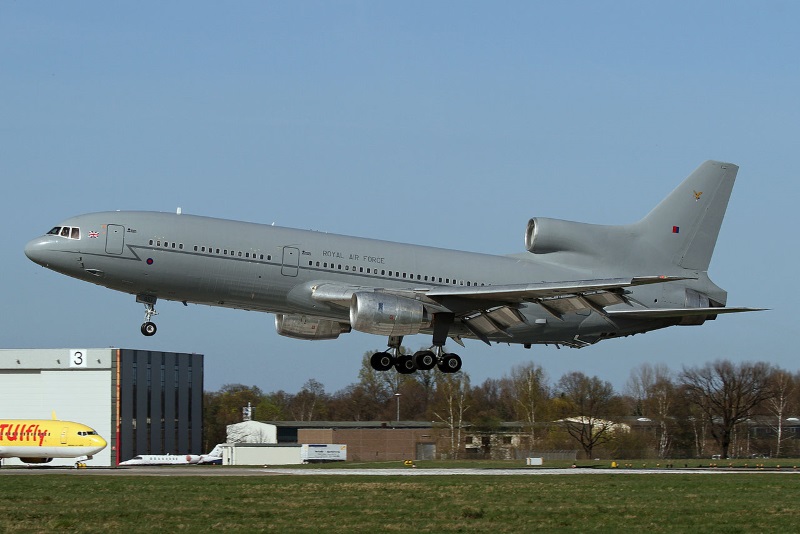
The RAF Tristars, nicknamed "Timmy" for some reason, were all operated by Number 216 Squadron, flying out of RAF Brize Norton. They appear to have been well liked by crews and had a productive service history, being employed in the 1991 Gulf War, interventions in the Balkans later in the 1990s, plus the Afghanistan and Iraq interventions in the next decade.
The Tristars were updated in service, notably with armor and directed infrared countermeasures systems for operations in Iraq. There was talk of giving the RAF Tristars an avionics refit, but their effective swan song was the NATO campaign against Libya in 2011 -- these aircraft being withdrawn in 2014, the last operational sortie being on 24 March of that year. The RAF acquired the Airbus A330 Multi-Role Tanker-Transport (MRTT) as a replacement.
In 2017 Tempus Applied Solutions of Williamsburg, Virginia, announced plans to obtain six of the ex-RAF Tristars, with three to be flown as inflight refueling tankers under contract to defense organizations, and the other three to be used as spares hulks. However, the deal fell through and the aircraft were scrapped.
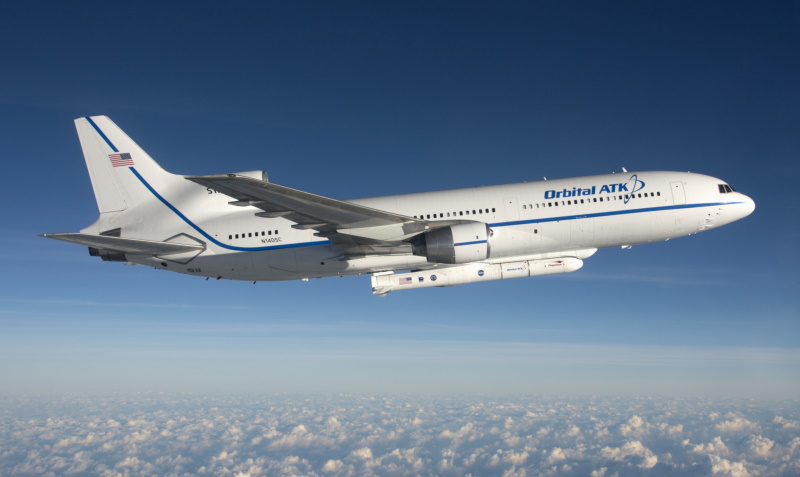
The last Tristar to remain flying was the "Stargazer", an L-1011-100 obtained by Orbital Sciences Corporation as the carrier aircraft for the Orbital Pegasus satellite launch booster. The Stargazer launched dozens of small satellites into orbit, though it appears it hasn't launched anything since 2021.
BACK_TO_TOP* Sources include:
Several editions of JANE'S ALL THE WORLD'S AIRCRAFT, the online Wikipedia, and the RAF website were consulted as well.
* Illustrations credits:
* Revision history:
v1.0.0 / 01 aug 15 v1.0.1 / 01 jul 17 / Review & polish. v1.0.2 / 01 feb 19 / Review, update, & polish. v1.0.3 / 01 jan 21 / Review, update, & polish. v1.0.4 / 01 feb 23 / Review, update, & polish. v1.0.5 / 01 feb 25 / Review, update, & polish. (+)BACK_TO_TOP
